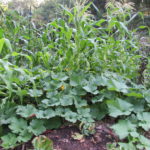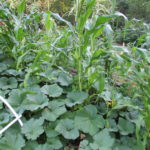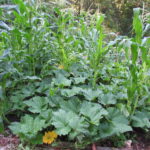I’m employing the three sisters method in my garden — with corn, beans and winter squash — all growing together. This is an ancient system and one that native Americans used but that we “modern folk” haven’t really picked up on.
The basic principle is that these three vegetables have a symbiotic relationship and, in this case, it’s a tremendously beneficial one. Let’s start with the corn. Corn is a heavy feeder so, to do well, it needs a lot of nitrogen. Enter the beans. The beans pull nitrogen from the air and supply it to the corn through the beans’ roots. In return, the corn supports the twining growth of the bean plants so you don’t need trellising or poles. Cool, right?
Now for the winter squash. We’ve all seen the huge growth of winter squash plants. They grow, they spread, they bush in gia-normous abandonment. The winter squash plants provide shade for the ground around the corn and bean plants. This helps hold the moisture in the soil and it eliminates the need for weeding. In addition, the prickly stems of the winter squash help keep some of the corn-lovin’ critters away from the tender ears of corn. Here’s what the Three Sisters method looks like here on The Little Half Acre:
There is also a “Four Sisters” method of gardening that adds either sunflowers or Bee Balm. I haven’t tried that method because there’s just not enough room but I like the idea. The sunflowers supposedly attract birds away from the ears of corn and the Bee Balm attracts pollinators.
There are a bunch of cool relationships in gardening and I only know/employ a few of them. For instance, I read that planting mustard in a carrot bed helps deter carrot fly. I think it worked. I had no problems with carrot fly until the mustard greens were crowded out by the carrot tops. Once the mustard greens died I found damage on about half the carrots I harvested.
I’ve always heard that tomatoes and basil grow well together so I planted basil between several tomato plants. I have never been able to grow basil before but this year, the basil plants are big and beautiful and I’ve been picking leaves and either using them fresh or drying them for storage. Yes, it could just be luck and it could be because I bought several basil plants from a fellow farmer’s market vendor instead of starting my own from seed (in the next post I’ll talk about my miserable lack of ability to start seedlings). Meanwhile, I’m going to continue the Three Sisters method and the practice of companion planting until I’m proven wrong.
The more I learn about permaculture and the interdependence of plants, the more optimistic I am about my future here on The Little Half Acre that Could. Any success stories from readers would be greatly appreciated – please feel free to comment and share your learning experiences!



